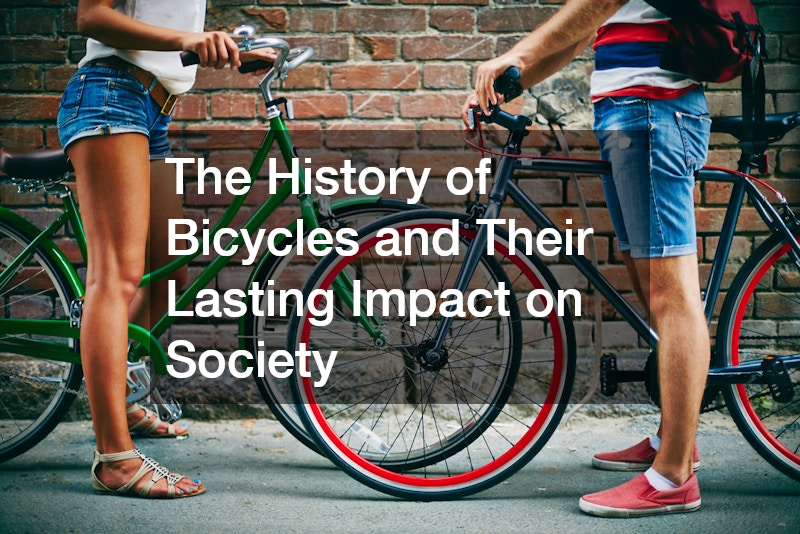Explore the fascinating history of bicycles, their evolution over time, and their profound impact on society. This article will delve into the development of bicycles, examine their societal implications, and predict future trends.
1. How Did Bicycles Originate and Evolve Over Time?
The Invention of the Bicycle
The inception of the bicycle began with the “Draisine,” invented by Karl von Drais in 1817, which was a two-wheeled, steerable vehicle without pedals. This contraption set the groundwork for other inventors to iterate and improve upon the basic concept, leading to more practical designs.
By the 1870s, the “Penny-farthing” emerged, featuring a large front wheel which provided a smoother ride compared to its predecessors. However, its high center of gravity made it hazardous, paving the way for further innovation and refinement in bicycle design.
In 1885, John Kemp Starley’s “Rover Safety Bicycle” debuted, featuring equally-sized wheels and a chain drive, revolutionizing bicycle safety and ride stability. This marked a significant milestone in bicycle evolution, setting the standard for modern bicycles as we know them today.
Technological Advancements and Modern Variations
As technology advanced, bicycles saw significant improvements in materials and design, including the introduction of air-filled tires by John Boyd Dunlop in 1888. This innovation greatly enhanced the comfort and performance of bikes, making them more appealing to a broader audience.
Modern bicycles now encompass a range of varieties, from road bikes to mountain bikes, each designed to suit different landscapes and rider preferences. Technological enhancements have also introduced features such as multiple gears, advanced braking systems, and lightweight frames.
In recent years, the advent of electric bikes has further diversified the realm of cycling, offering powered assistance that makes cycling accessible to more people. The integration of technology continues to drive bicycle evolution, catering to both enthusiast riders and casual commuters alike.
2. What Is the Economic and Environmental Impact of Bicycles?
Bicycles and Economic Growth
Bicycles contribute to economic development by providing a cost-effective transportation alternative, reducing the need for costly infrastructure investments. Cycling industries, including manufacturing, sales, and repairs, create jobs and stimulate local economies.
In areas where bicycles are a dominant mode of transportation, they contribute significantly to household savings, allowing disposable income to be directed elsewhere. The affordability of bicycles makes them an attractive option for those seeking financial efficiency in their daily commutes.
Furthermore, cities that support cycling culture often experience increased tourism, as bicycle-friendly environments attract visitors interested in eco-friendly travel. By fostering a bike-friendly atmosphere, cities can boost their economies and improve the quality of life for residents.
Environmental Benefits
One of the most profound impacts of bicycles is their contribution to reducing carbon emissions, as they are a clean and sustainable form of transportation. By encouraging cycling over car usage, cities can significantly decrease pollution levels and improve air quality.
Bicycles also play a role in urban planning by reducing the demand for extensive road networks and parking spaces. This allows cities to allocate land for green spaces, further enhancing environmental sustainability and urban livability.
As urban areas continue to grapple with congestion and pollution, promoting bicycle usage presents a viable solution for mitigating these challenges. The environmental advantages of cycling align with global efforts to combat climate change and promote sustainable urban development.
3. How Do Bicycles Impact Personal Health and Urban Life?
Health Benefits of Cycling
Cycling is an excellent form of low-impact exercise that offers numerous health benefits, including improved cardiovascular health and increased muscle strength. Regular cycling can help prevent both physical and mental health issues, contributing to overall well-being.
The mental health benefits of cycling are also notable, as it can reduce stress, anxiety, and depression, providing a sense of freedom and connection to the surrounding environment. Cycling has been shown to elevate mood and enhance cognitive function, thanks to the release of endorphins.
Engaging in regular cycling helps maintain a healthy weight, lowers the risk of chronic diseases, and improves coordination and balance. By incorporating cycling into daily routines, individuals can significantly enhance their quality of life and longevity.
Influence on Urban Infrastructure and Lifestyle
Bicycles play an essential role in shaping urban infrastructure, prompting the development of dedicated bike lanes, parking facilities, and traffic calming measures. These infrastructure investments lead to safer and more accessible environments for all urban dwellers.
In cities around the world, the rising popularity of bicycles is encouraging a shift towards more sustainable and active lifestyles. By reducing dependency on cars, cities can alleviate congestion, improve air quality, and promote healthier living standards.
As bicycles encourage a greater sense of community, they enhance social connection among residents, fostering a culture of inclusivity and environmentally-conscious living. In urban areas, cycling is not just a mode of transport but a lifestyle choice that resonates with broader efforts for sustainable urban development.
The historical significance of bicycles is undeniable, from their humble beginnings to their current role as a critical component of modern transportation systems. As society continues to adapt to challenges such as climate change and urbanization, bicycles offer innovative solutions that enhance economic, environmental, and social well-being.
The ongoing impact of bicycles on society is evident in their influence on urban planning, personal health, and economic development. Looking to the future, bicycles will remain a linchpin in the development of sustainable transport solutions, continuing to shape and inspire the world around us.


